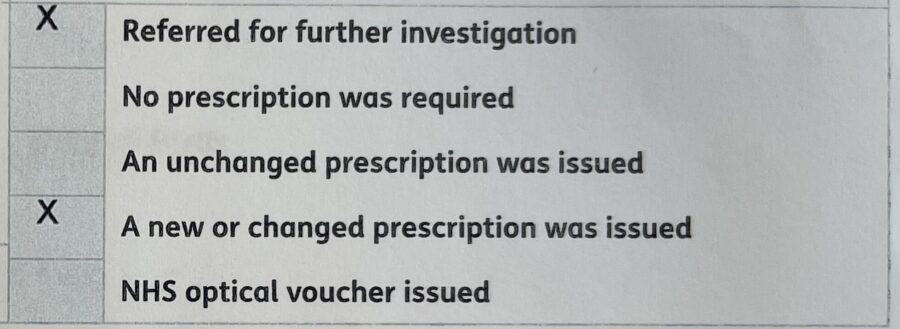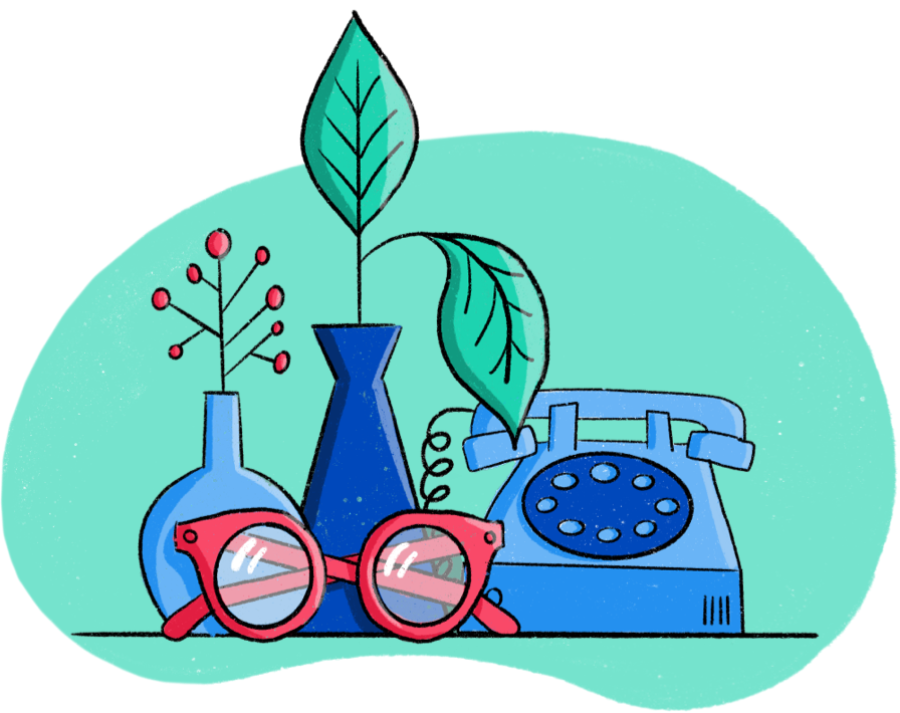Blog post
Understanding your Eye Test Prescription and Receipt

Matthew Burford BSc(Hons) Optometry MCOptom - Domiciliary Optician and Professional Services Manager at OutsideClinic

Regular eye tests are essential for keeping your eyes healthy and ensuring your vision is always at its best. After your test, one of our expert opticians will provide you with a prescription – but what does it all mean? Let’s take a closer look at what’s included in your prescription and the key areas to focus on.

Patient details

Every prescription begins with your personal details, including your name, date of birth, address and postcode. Following this, you’ll find a summary of the examination results, often presented as a checklist. This section highlights the findings and outlines the next steps recommended by your optician. Common examples include:
- Referred for further investigation. (This is normally checked if cataracts are spotted and surgery is recommended).
- No prescription was required.
- An unchanged prescription was issued.
- A new or changed prescription was issued.
- NHS optical voucher issued. Vouchers are issued if you qualify for NHS support, offering a discount on glasses. View the criteria for NHS eligibilty.

Reading your prescription
Your prescription will include a table containing numbers within, referring to the 4 subjects: Sph, Cyl, Axis, Prism. Within each section under the titles, will be a number for your right eye (R) and your left eye (L). The numbers will come either as a positive or a negative (+/-), this simply refers to your lens power.

Sph (otherwise known as sphere):
Sph on your prescription stands for sphere. This refers to amount of lens power that is needed, measured normally in a dioptre unit, to correct your vision. The sign used (+ or -) will highlight whether you are long-sighted or short-sighted. The higher the number means the more power that is needed e.g. +0.50 vs +4.50.
Cyl (otherwise known as cylinder):
Cyl on your prescription stands for cylinder, which indicates the amount of correction needed for astigmatism - meaning the lens power needed to address any irregular curvature in your eye’s cornea or lens. Astigmatism often described as a 'rugby ball shape.' Learn more about astigmatism here.
However, if you do not have any astigmatism present, this section will be left empty as your eyes are spherical.
Axis:
Axis refers to the angle of your astigmatism, indicating the direction in which correction is needed. This is usually shown in degrees, ranging from 1° to 180°.
Prism:
Prism refers to the adjustment made to your lenses, helping to align your eyes and correct certain binocular vision issues, such as double vision (diplopia) if required. If blank, this means that a prism is not needed within your glasses.
LogMAR:
LogMAR is an objective scale used by us to quantify your visual acuity. An alternative scale is Snellen Acuity form, primarily used in America and shown as 20/20 vision, or 6/6 in the UK. LogMAR is similar, however ranges from positives and negatives. A lower LogMAR value indicates better visual acuity (e.g. 0 is the same 20/20 vision), while a higher value signifies poorer visual performance (e.g. 0.3 is 6/12).
Add:
Add indicates the extra lens power prescribed for reading or other near-vision activities. Measured in dioptres, this prescription is applied to the lower portion of bifocal, trifocal or progressive lenses to aid with close-up tasks.
NearVA:
NearVA is similar to logMAR but specifically measures near vision. It quantifies how well a person can see objects up close, typically measured at a standard distance of about 14 to 16 inches (35 to 40 cm).

Receipt
Your receipt provides a summary of any costs related to glasses or the examination, along with other useful details. The main sections on the receipt include:
Eye examination type:
If you qualified for an NHS examination, it will be noted here. Eligible individuals do not pay for their eye test. View the criteria for NHS eligibilty.
NHS voucher value:
If you qualify, the value of your NHS voucher is based on your prescription and the required lens type. This amount is then deducted from your final total. At OutsideClinic, we further subsidise this to provide a ‘voucher allowance’.
Accessories:
This section is for any additional products that were bought during the visit, such as drops or eye gel. Displayed will be the costs and the details of the products.
Final Total:
This section summarises all costs into a final total for the visit. It includes any deposits, payment methods and any outstanding balance. If an order of glasses is noted as ‘on-hold,’ it means the order is temporarily paused at the customer's request.

By Matthew Burford BSc(Hons) Optometry MCOptom - Domiciliary Optician and Professional Services Manager at OutsideClinic Post last updated 4th November 2025
Matthew graduated from Aston University in 2004 with a degree in Optometry.



